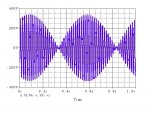oldsparky52
Senior Member
- Location
- Wilmington, NC USA
I have 2 1600-watt continuous inverters of different manufacturers. One to run the fridge and lights the other to run a window AC or a coffee pot.
If the neutrals of the 2 inverters are tied together, and the "hots" never see a common load (no 240-volt loads), would there be a problem? The scenario is that the neutrals from the inverters would be landed on the neutral bar of the panel and the "hots" would be removed from the CB an wire-nutted to the "hots" from the inverters (separately of course). I have no idea what the L to L voltage would be from the 2 inverters, but don't really care since they are not going to be used in that manner.
My gut says they will be fine, but ... I'm not 100% positive but can't think of the scenario that there would be a problem. If there is one, I'm sure y'all will come up with it.
If the neutrals of the 2 inverters are tied together, and the "hots" never see a common load (no 240-volt loads), would there be a problem? The scenario is that the neutrals from the inverters would be landed on the neutral bar of the panel and the "hots" would be removed from the CB an wire-nutted to the "hots" from the inverters (separately of course). I have no idea what the L to L voltage would be from the 2 inverters, but don't really care since they are not going to be used in that manner.
My gut says they will be fine, but ... I'm not 100% positive but can't think of the scenario that there would be a problem. If there is one, I'm sure y'all will come up with it.


